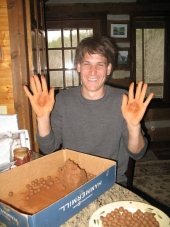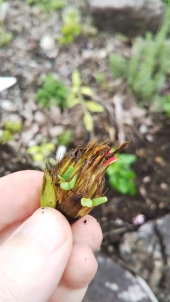





 2
2





"But if it's true that the only person over whom I have control of actions is myself, then it does matter what I do. It may not matter a jot to the world at large, but it matters to me." - John Seymour




Permaculture in Croatia:
www.perforum.info




 This year I've broadcast about 1/4 hectare with a game seed mixture mixed with red clover. I just broadcast the bare seeds on top of the almost bare soil and in time most of the clover seeds germinated. I even managed to grow some fodder kale. The rest of the stuff in my game seed mixture did not germinate or were eaten or something, I don't really know.
This year I've broadcast about 1/4 hectare with a game seed mixture mixed with red clover. I just broadcast the bare seeds on top of the almost bare soil and in time most of the clover seeds germinated. I even managed to grow some fodder kale. The rest of the stuff in my game seed mixture did not germinate or were eaten or something, I don't really know.
"But if it's true that the only person over whom I have control of actions is myself, then it does matter what I do. It may not matter a jot to the world at large, but it matters to me." - John Seymour




Permaculture in Croatia:
www.perforum.info




 (it has always sounded WAY too complicated but as a last resort when nothing else has worked...) maybe the position of the moon has been wrong every time I sowed grains (and French beans, which also totally failed this year despite doing very nicely last year) or.... as you can see I know nothing at all about biodynamic farming
(it has always sounded WAY too complicated but as a last resort when nothing else has worked...) maybe the position of the moon has been wrong every time I sowed grains (and French beans, which also totally failed this year despite doing very nicely last year) or.... as you can see I know nothing at all about biodynamic farming  ops:
ops:
"But if it's true that the only person over whom I have control of actions is myself, then it does matter what I do. It may not matter a jot to the world at large, but it matters to me." - John Seymour




 It would only need a couple of pecks for them to realise there is food inside.
It would only need a couple of pecks for them to realise there is food inside.








The ultimate goal of farming is not the growing of crops, but the cultivation and perfection of human beings. - Masanobu Fukuoka








Rose Pinder wrote:The thing about Fukuoka is that his system is really about the relationship between the person and the environment, rather than a set of techniques (permaculture is like this too). What you could do now is continue with the experiments on your land and learn from them, which is what Fukuoka did. It's that deeper learning and relationship with the land that made Fukuoka successful.
M Troyka wrote:
The only thing I can think of would be to make them bigger, and make sure they're completely dry before throwing them out. Hard clay is quite challenging to break open, but if it really was crows then there's a good chance they'll figure it out anyway. Crows are insufferably intelligent, but if you make them enough of a pain just for one seed, they may decide it isn't worth it anymore (or they may just throw them in the road for cars to break).
 Yes I can imagine them doing that. Or even better, throw them at the cars hard enough to dehull the seeds as well
Yes I can imagine them doing that. Or even better, throw them at the cars hard enough to dehull the seeds as well 
M Troyka wrote: The only alternatives I can think of would be to direct seed with a hole-punching stick and plug it with clay (ie lots of work) or maybe try to make peace with the crows by giving them an offering of hard boiled eggs and other birdseed stuff.




The ultimate goal of farming is not the growing of crops, but the cultivation and perfection of human beings. - Masanobu Fukuoka








Xisca - pics! Dry subtropical Mediterranean - My project
However loud I tell it, this is never a truth, only my experience...








Xisca - pics! Dry subtropical Mediterranean - My project
However loud I tell it, this is never a truth, only my experience...









winston wilcox wrote:What if its not a bird..... and instead maybe a squirrel or rat type critter?!?!

I have also heard of mixing potent smelling essential oils into the mix with seedballs to make them unatractive to predators.
"But if it's true that the only person over whom I have control of actions is myself, then it does matter what I do. It may not matter a jot to the world at large, but it matters to me." - John Seymour
 1
1




Jordan Lowery wrote:Simply sow your seedballs hours or minutes before a storm comes in and it starts to rain. Preferably a storm that will last a few days.
I do this with my sunflower seeds as the birds get them if I toss them out with too many days to "forage" theftesh seed, after a big rain the seeds are usually hidden by debris or sprout far enough like the wheat to where the birds won't bother them at first
Jordan Lowery wrote: birds ate my entire first seedball experiment too)

"But if it's true that the only person over whom I have control of actions is myself, then it does matter what I do. It may not matter a jot to the world at large, but it matters to me." - John Seymour




Xisca - pics! Dry subtropical Mediterranean - My project
However loud I tell it, this is never a truth, only my experience...




Our projects:
in Portugal, sheltered terraces facing eastwards, high water table, uphill original forest of pines, oaks and chestnuts. 2000m2
in Iceland: converted flat lawn, compacted poor soil, cold, windy, humid climate, cold, short summer. 50m2




Paulo Bessa wrote:I have a similar problem with birds. I learn to co-exist with them.
So now I have tested different things: I put a cover and I started some trays with rye inside first. Its too much work but at least it works. Against the slugs I sown in beds with bare soil. .
 (This has been a lousy summer in Finland, very rainy and only one really warm week... so that has something to do with the lack of yield for sure).
(This has been a lousy summer in Finland, very rainy and only one really warm week... so that has something to do with the lack of yield for sure).
"But if it's true that the only person over whom I have control of actions is myself, then it does matter what I do. It may not matter a jot to the world at large, but it matters to me." - John Seymour
 2
2




Home & LifeStyle Building Training. How to transition from the Rat Race to Freedom!
https://upvir.al/56817/lp56817
Also, Chechout My YouTube Channel
https://www.youtube.com/channel/UC-rd5G_2jWSV-sAi-xpdFZA
 2
2




A lot of things come out of nowhere, so look everywhere.
 1
1








 Good luck!
Good luck!
Study nature, love nature, stay close to nature. It will never fail you. ~Frank Lloyd Wright
 2
2




Iterations are fine, we don't have to be perfect
My 2nd Location:Florida HardinessZone:10 AHS:10 GDD:8500 Rainfall:2in/mth winter, 8in/mth summer, Soil:Sand pH8 Flat




 2
2




onestrawrevolution.com
There is no time in modern agriculture for a farmer to write poetry or compose a song -- Masanobu Fukuoka




Milan Broz wrote:I've red that chilli pepper added to the mix can help. What you think?




 2
2








alex Keenan wrote:All you have to do is add a artifical grape flavoring. This has been use for a while because birds can not stand it and it does not harm anything.
You can find several papers on this. Cool-aid grape is the cheapest way to try this. Just add it to your mix.
Mike
http://tenderfootfarmer.ca




Be most excellent to each other.









 2
2




How Permies works: https://permies.com/wiki/34193/permies-works-links-threads
My projects on Skye: The tree field, Growing and landracing, perennial polycultures, "Don't dream it - be it! "

 3
3




Nancy Reading wrote:I'm thinking that seedballs probably won't be much use in a predominately wet climate like mine?
- Tim's Homestead Journal - Purchase a copy of Building a Better World in Your Backyard - Purchase 6 Decks of Permaculture Cards -
- Purchase 12x Decks of Permaculture Cards - Purchase a copy of the SKIP Book - Purchase 12x copies of Building a Better World in your Backyard












 4
4




How Permies works: https://permies.com/wiki/34193/permies-works-links-threads
My projects on Skye: The tree field, Growing and landracing, perennial polycultures, "Don't dream it - be it! "

 1
1





|
Wait for it ... wait .... wait .... NOW! Pafiffle! A perfect tiny ad!
Freaky Cheap Heat - 2 hour movie - HD streaming
https://permies.com/wiki/238453/Freaky-Cheap-Heat-hour-movie
|







